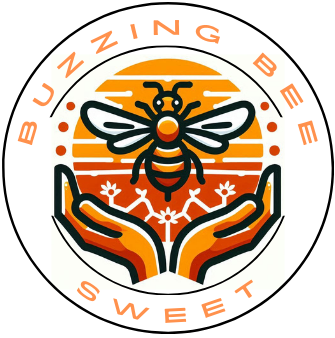Honey harvesting starts with understanding the busy world of bees. These little wonders aren’t just buzzing around for fun; they’re crucial for that sweet, golden treat we love. Imagine thousands of busy bees working together in perfect harmony, transforming nectar into honey, an amazing feat of nature.
Beekeeping is more than just a hobby—it’s a deep commitment to maintaining a healthy environment. Every beekeeper needs to grasp the lifecycle of bees. From the queen bee and her tireless workers to the drones, each plays a role in a working ecosystem that ultimately produces honey.
It’s all about nurturing strong bee colonies. Healthy, thriving bees mean more honey. Investing time in getting your bees fed and disease-free isn’t just nice to do; it’s your ticket to a bountiful harvest.
Timing is everything in honey harvesting. Different seasons and regional climates change how bees work and, importantly, when they’re ready to share their honey bounty. Keeping an eye on weather patterns and understanding the local bloom season are key moves for effective harvesting.
Knowing the basics sets the stage for a rewarding relationship with your bees and a fruitful harvest of honey.
Preparation for a Successful Honey Harvest
Let’s get into the nitty-gritty of preparing for a honey harvest, because showing up ready is half the battle. You wouldn’t dive into a pool without checking the water, right? Same goes for harvesting honey—you need the right gear and know-how to make it work.
First off, let’s talk tools of the trade. Beekeeping gear is your frontline defense. We’re talking about protective clothing, smokers to calm the bees, and hive tools for prying open those sticky frames. A good setup makes all the difference, letting you focus on the task without worrying about a bee invasion.
Timing when you harvest is pretty much the golden rule here. Honey’s gotta be mature, otherwise, it’s like picking green bananas—just not the same. You’ll need to peek into those honeycombs every now and then. Look for capped honey cells, which shows it’s ripe and ready.
Another crucial part of preparation is making choices that respect the bees and the environment. We’re talking ethical practices here. This isn’t just about honey—it’s a two-way street with our buzzing buddies. Make sure they have enough honey left for themselves, especially with cooler months lying ahead. It’s all about balance and care in your approach.
Preparation might feel daunting at first, but it’s your blueprint to a truckload of sweet, clean honey. Plus, the payoff is not just in the honey but also in seeing your bees thrive.
The Honey Harvesting Process: Step by Step
Starting with a good approach to the hive is key in making sure you and your bees stay chill. You want those protective beekeeping suits zipped up right, and the smoker prepped to help keep the bees calm and collected.
Next, deal with those frames. This is hands-on work where you remove the frames all lined with honeycomb. Being gentle here is important, since those combs are delicate structures of bustling bee life.
Look for frames with honeycombs where most of the cells are covered. If the cells are not covered, the honey probably contains too much moisture. The bees check when the honey has the right moisture content, about 15-17%, and then they cover the cells.
Once those frames are out, it’s all about extracting that honey. You can rely on methods like the trusty centrifugal extractor for the job. This spin method gets all the honey out without wrecking the comb.
After extracting, the honey isn’t quite ready for your toast or tea yet. It needs some filtering to remove stray bits of wax or the odd bee part. Filtering is one step that keeps your honey pure and smooth.
Storage could sound like an afterthought, but getting it right is crucial for keeping that honey in peak form. Clean, airtight containers in a cool place keep the good stuff fresh and delicious.
Experience is your best friend during this process. It teaches you efficiency and sensitivity to what your bees need and how to handle the harvest smoothly. Over time, you get a rhythm that makes everything flow better.
Beyond the Hive: Utilizing Harvested Honey
Storing honey the right way keeps it in optimal condition, so it stays as tasty as when you first jarred it. Clean, airtight jars away from heat and light will keep honey fresh for ages—if it even lasts that long in your house.
The kitchen is your playground with honey on hand. From classic glazes and marinades to gourmet desserts, it’s that secret ingredient that packs both flavor and health benefits. It’s like having a golden ticket to culinary creativity.
Speaking of health, honey isn’t just a sweetener; it’s a natural remedy. Think soothing sore throats, boosting energy, or even skincare routines. Its antibacterial properties can be a real helper when you need a natural boost.
Selling honey can also be a way to connect with your community. Farmers’ markets, local shops, or online—sharing your honey introduces you and your bees to the world. Plus, you get to educate others about why honey and bees matter, spreading the buzz about the importance of pollinators.
Whether it’s for culinary exploits, health perks, or sharing the bounty, harvested honey opens doors to a world of opportunities and connections.

This article on harvesting honey is incredibly informative! I love how you’ve walked through the process step-by-step, from checking the hive to extracting the honey. The tips on ensuring honey quality and safety are especially useful. It’s clear that you’ve shared a lot of knowledge, making it easier for both beginners and experienced beekeepers. Thanks for sharing these valuable insights—it’s definitely going to help anyone looking to harvest honey successfully!
Hi Mercy!
Thank you for your comments and thoughts!
/Mats